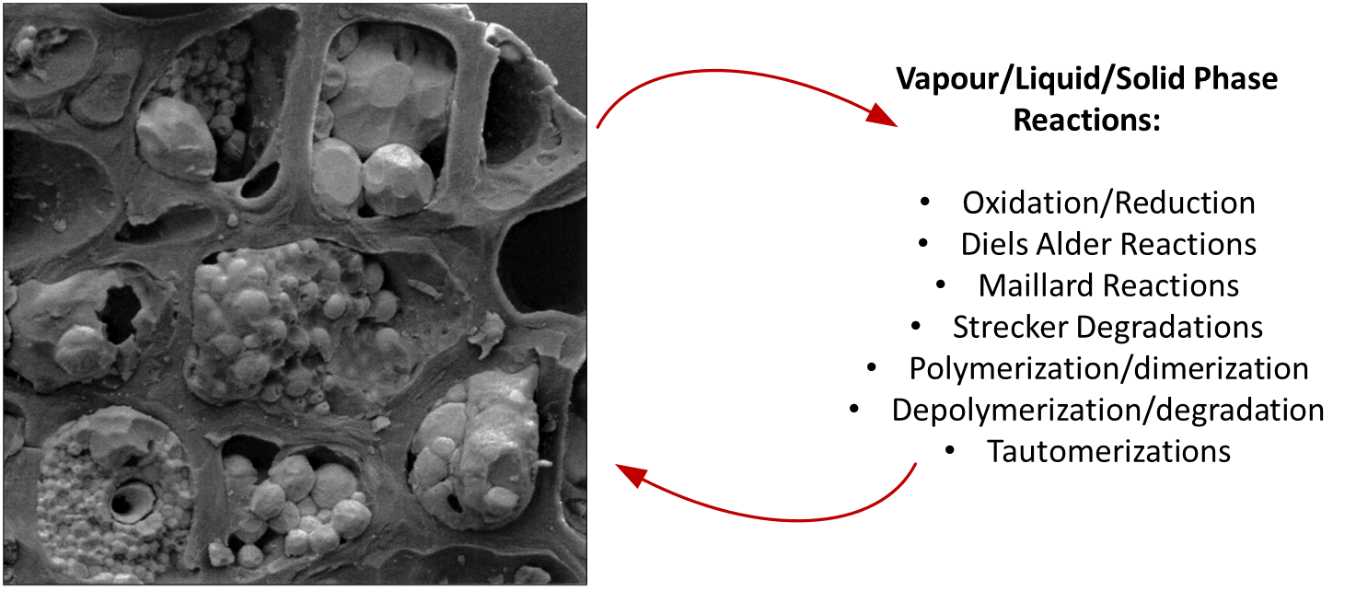
อายุการเก็บรักษาและการบ่มกาแฟ
บทความนี้เป็นบทนำเรื่องเพื่อเข้าสู่เนื้อหาที่ CSEC กำลังศึกษาเพิ่มเติม ในเรื่องเคมีในกาแฟที่เกิดขึ้นจากการบ่มเมล็ดขณะเก็บกาแฟไว้ก่อนนำมาชง
มีความคิดเห็นต่างๆ นานาในเรื่องว่าควรเก็บเมล็ดกาแฟที่คั่วแล้วไว้นานเท่าไร จึงจะดีที่สุดเมื่อนำมาชงดื่ม แม้แต่ในบริษัทของเราเอง ก็ยังมีความคิดเห็นต่างๆ หลากหลาย บ้างก็มาจากความเชื่อ บ้างก็มาจากแชมป์โลกบาริสต้า และบ้างก็มาจากความนิยมชมชอบส่วนตัว
มันน่าสับสนครับ
เราจึงตัดสินใจว่าจะต้องใช้วิธีการทางวิทยาศาสตร์มาพิสูจน์เรื่องนี้ บทความนี้ (และโพสต์อื่นๆ ที่จะตามมาเมื่อเราได้รับข้อมูลใหม่ๆ) เรามาหาคำตอบในเรื่องต่อไปนี้
ควรบ่มกาแฟไว้นานเท่าไรก่อนนำมาชงดื่ม
โดยสรุป เราพบว่า:
- กาแฟที่เก็บในแพคเกจปกติ (ไม่ใช่แบบที่เติมไนโตรเจน) ควรนำมาชงดื่มภายใน 1-3 สัปดาห์จากวันที่คั่วกาแฟ (ดีที่สุดคือช่วง 1.5 สัปดาห์)
- กาแฟที่เก็บในแพคแกจแบบเติมไนโตรเจน จะให้รสชาติดีที่สุดหลังเก็บไว้ 2 สัปดาห์

ภาพที่ 1 ระยะเวลาที่แนะนำให้บ่มกาแฟก่อนดื่ม เราแนะนำให้ใช้กาแฟไม่เติมไนโตรเจน (บรรจุแบบธรรมดา) หลังบ่ม 1 สัปดาห์ ส่วนกาแฟที่บรรจุแบบเติมไนโตรเจน หากดื่มเป็นกาแฟดำ จะให้รสชาติดีที่สุดหลังบ่ม 2 สัปดาห์ แต่ยกเว้นเครื่องดื่มกาแฟผสมนม หากเป็นกาแฟที่บรรจุแบบเติมไนโตรเจน แนะนำให้ชงแบบผสมนมได้หลังบ่ม 1 สัปดาห์ ความรุนแรงของรสชาติกาแฟแบบเติมไนโตรเจนที่มีอายุการเก็บหนึ่งสัปดาห์ เมื่อผสมกับนมจะให้รสชาติที่ดีกว่ากาแฟแบบไม่เติมไนโตรเจนมาก
เราตัดสินอย่างไร
ก่อนอื่นต้องถามว่า การบ่มกาแฟ (Ageing) คืออะไร
การบ่มกาแฟ (Ageing) คือการรอเวลาเพื่อให้กาแฟพัฒนารสชาติขึ้น เป็นผลทางบวก แต่คำว่าเหม็นหืน (Staling) เป็นผลจากกระบวนการเดียวกันในการเก็บกาแฟ แต่เกิดผลในทางลบกลายเป็นกลิ่นหืน เมื่อพูดถึงการเก็บกาแฟ ไม่ว่าผลจะออกมาทางบวกหรือลบ กาแฟคั่วก็เปลี่ยนแปลงรสชาติไปตลอดเวลาตามระยะเวลาการเก็บ เป็นการเปลี่ยนแปลงที่เราสัมผัสรับรู้ได้
รสชาติของกาแฟที่เปลี่ยนแปลงไปนั้นเป็นผลมาจากปรากฏการณ์ธรรมชาติ 2 ปรากฏการณ์คือ
- การถ่ายโอนทางเคมี (Chemical transportation)
- • การเปลี่ยนรูปทางเคมี (Chemical transformation)
การถ่ายโอนทางเคมี คือ การเคลื่อนที่ขององค์ประกอบเคมีของกาแฟออกไปสู่สภาพแวดล้อมภายนอก ด้วยวิธีการแพร่และการถ่ายโอนมวลสาร ปรากฏการณ์นี้ทำให้คาร์บอนไดออกไซด์ สารระเหยง่าย ฟลาโวนอยด์ ไขมันและองค์ประกอบที่เป็นของเหลวและของแข็ง ที่มีอยู่ในกาแฟ เคลื่อนที่และถูกถ่ายโอนออกมายังบรรยากาศโดยรอบ เมื่อสารเหล่านี้ถูกถ่ายโอนออกจากเมล็ดกาแฟแล้ว ทั้งคาร์บอนไดออกไซด์ สารระเหยง่าย น้ำ อากาศ และสารเคมีอื่นๆ ก็จะถูกถ่ายโอนกลับไปยังเมล็ดกาแฟอีกเช่นกัน ภาพด้านล่างอธิบายปรากฏการณ์นี้

ภาพที่ 2 กลิ่นรสของกาแฟและสารเคมีอื่นๆ ที่เกิดขึ้นจากการคั่ว เปลี่ยนแปลงกลายเป็นไอ แล้วจึงเปลี่ยนกลับมาเป็นรูปเดิม
ปรากฏการณ์ที่สองหมายรวมถึงปฏิกิริยาเคมีทั้งหมดที่เกิดขึ้นตลอดช่วงเวลานั้น ซึ่งรวมทั้งปฏิกิริยาที่เกิดในรูปไอน้ำ ของเหลว และของแข็ง ซึ่งอาจเป็นได้ทั้งปฏิกิริยาออกซิเดชัน (Oxidation) ปฏิกิริยารีดักชัน (Reduction) ปฏิกิริยาการเกิดพอลิเมอร์ (Polymerization ซึ่งรวมทั้งไดเมอร์ไรเซชั่น dimerization) ปฏิกิริยาไฮโดรไลซิส (hydrolysis) และอื่นๆ ปฏิกิริยาเหล่านี้จะเปลี่ยนแปลงองค์ประกอบของกาแฟไปเรื่อยๆ ซึ่งอาจส่งผลรส (taste) และกลิ่น (aroma) ของกาแฟที่เรารับได้ให้เปลี่ยนแปลงไปมากทีเดียว

ภาพที่ 3 ปฏิกิริยาเคมีที่เกิดขึ้นกับกาแฟนั้นจะเกิดขึ้นทั้งสองขั้นตอน ผลิตภัณฑ์ที่ได้จากปฏิกิริยาเคมีจะเปลี่ยนกลับไปมาระหว่างสองขั้นตอนนี้ รสชาติของกาแฟจึงเปลี่ยนไปตลอดเวลา
เรื่องนี้เป็นเรื่องซับซ้อน และจะยิ่งซับซ้อนขึ้นไปอีกเมื่อพิจารณาปัจจัยอื่นๆ ร่วมด้วย ได้แก่ แหล่งกำเนิดกาแฟ ระดับการคั่ว ค่าวอเตอร์แอคทีวิตี (water activity) หรือระดับพลังงานของน้ำทั้งก่อนและหลังคั่ว รวมทั้งสภาพอากาศโดยรอบ ปัจจัยทั้งหมดนี้มีผลต่ออายุการเก็บ การนำทุกกลไกและปัจจัยที่มีผลต่อรสชาติของกาแฟมาพิจารณาให้ครบนั้นเป็นเรื่องยาก แต่เราก็ได้เริ่มลงมือแล้ว เราได้ทำการศึกษาแบบไม่ซับซ้อนมากนัก เพื่อให้ทราบระยะเวลาการเก็บที่เหมาะที่สุดก่อนนำกาแฟมาชงดื่ม
เราทำอะไรบ้าง (เราทดสอบกันอย่างไร) เราวางแผนที่จะทำการทดลองเพื่อสังเกตการเปลี่ยนแปลงทั้งในเชิงปริมาณและเชิงคุณภาพที่เกิดกับกาแฟคั่วทั้งสามแบบ คือกาแฟเบลนด์แบบคั่วอ่อน คั่วกลาง และคั่วเข้ม กาแฟทั้งหมดนี้คั่วในวันเดียวกัน ซึ่งมีสภาพบรรยากาศเหมือนกัน เราสังเกตความแตกต่างระหว่างกาแฟที่บรรจุแบบเติมไนโตรเจน (gas flushed**) (2 ส่วนต่อออกซิเจน 100 pph) และกาแฟที่บรรจุแบบไม่เติมไนโตรเจน (21pph) แล้วจึงทำการชิมรสชาติกาแฟเมื่อมีอายุการเก็บ 1, 2, 4 และ 8 สัปดาห์
(**gas flushing คือกระบวนการเติมไนโตรเจนเข้าไปในระหว่างการบรรจุเมล็ดกาแฟ เพื่อชะลอการเกิดปฏิกิริยาออกซิเดชั่น ซึ่งช่วยยืดอายุการเก็บรักษา)
- เราชิมรสชาติกาแฟ ร่วมกันกับนักชิมกาแฟ 5 คนที่ผ่านการฝึกฝนมาแล้ว (มีนักชิมที่เป็น Q-grader อยู่ในกลุ่มด้วย)
- เราคำนึงถึงรสนิยมส่วนตัวของนักชิมแต่ละคน และจดบันทึกลงไว้ในผลที่ได้ (เช่น ความต่างของกลิ่นหรือรสที่รับได้)
- เราให้คะแนนกาแฟในแต่ละหัวข้อ โดยคะแนนเต็มคือ 5 หัวข้อในการประเมินมีดังนี้ ความหวาน เมาธ์ฟีล รสเมื่อผสมกับนม (เราชิมทั้งแบบผสมนมและกาแฟดำ) และบาลานซ์
- เราจับคู่กลิ่นรสที่ได้กับช่วงเวลาการเก็บด้วย
- อุณหภูมิโดยรอบเป็นปัจจัยที่ไม่ได้คำนึงถึงหรือควบคุมในการศึกษาครั้งนี้ (การศึกษาขั้นที่ 2 จะคำนึงถึงเรื่องนี้) อย่างไรก็ตามอุณหภูมิในห้องที่ใช้เก็บกาแฟอยู่ที่ราว 18-26 องศาเซลเซียส
- ปัจจัยอื่นๆ ที่ไม่ได้ควบคุมในการศึกษาครั้งนี้คือ ความชื้นสัมพัทธ์ระหว่างการคั่ว ระยะเวลาพักเมล็ดก่อนบรรจุ และความดันบรรยากาศโดยรอบ (จะศึกษาในขั้นที่ 2)
แต่เราท่านก็ทราบกันดีว่าผลการศึกษาทางวิทยาศาสตร์เป็นเรื่องที่ต้องนำมาเปรียบเทียบ ตัวเลขที่ได้ออกมานี้จะไม่มีความหมายเลยถ้าไม่มีตัวเลขมาตรฐานที่นำมาเทียบเคียงได้ ถ้าอย่างนั้นค่ามาตรฐานใดที่เราใช้เป็นหลักเพื่อนำผลที่ได้จากการศึกษามาเทียบเคียง ในการศึกษาครั้งนี้เราไม่รู้ว่ากาแฟที่อายุการเก็บเท่าใดจึงจะเหมาะเป็นค่ามาตรฐานเพื่อนำค่าอื่นมาเปรียบเทียบ (แต่ตอนนี้เรารู้แล้วเพราะได้เริ่มการทดลองขั้นที่ 2) ดังนั้นในการศึกษาครั้งนี้ เราจึงรายงานผลโดยเปรียบเทียบกาแฟที่บรรจุแบบเติมไนโตรเจน (flushed) กับแบบไม่เติมไนโตรเจน (non-flushed) หรือพูดอีกนัยหนึ่งคือ เราคอยตามตรวจสอบคุณภาพของกาแฟไม่เติมไนโตรเจน ซึ่งมีการพัฒนารสชาติและเสื่อมคุณภาพไป โดยเปรียบเทียบกับกาแฟเติมไนโตรเจน เราไม่ได้ตั้งข้อสันนิษฐานว่ากาแฟที่เติมไนโตรเจนจะไม่มีการเปลี่ยนแปลง เพราะไม่ว่าอย่างไรก็จะยังคงเกิดปฏิกิริยาต่างๆ อยู่ แต่สิ่งสำคัญที่ต้องสังเกตคือจุดที่เกิดความแตกต่างด้านคุณภาพ (เช่น เมื่อถึงจุดที่กาแฟแบบเติมไนโตรเจนมีคุณภาพเหนือกว่ากาแฟไม่เติมไนโตรเจน) และจุดที่กาแฟเสื่อมคุณภาพจนไม่ควรนำมาดื่มอีกต่อไป
ผลการศึกษาที่เราค้นพบ
เราพบว่ากาแฟที่บรรจุแบบไม่เติมไนโตรเจน เหมาะจะดื่มมากที่สุดภายใน 3 สัปดาห์หลังคั่ว (จะดีที่สุดในช่วง 1.5 สัปดาห์) ส่วนกาแฟที่บรรจุแบบเติมไนโตรเจน จะมีรสชาติดีที่สุดหลังจากเก็บไว้ 2 สัปดาห์
เราสรุปผลการศึกษาไว้เป็นคะแนนมาตรฐาน (normalized score) เทียบกับจำนวนสัปดาห์หลังคั่ว ตามแผนภาพด้านล่าง

ภาพที่ 4 ผลคะแนนมาตรฐานของการศึกษาความสดใหม่ของกาแฟโดยมีคะแนนเต็ม 10 และ error bars ในแกนตั้งหมายถึงค่าที่เกิดจากคะแนนที่นักชิมแต่ละคนให้ต่างกัน และ error bars ในแกนนอนหมายถึงความแปรปรวน (average variances) ระหว่างระดับการคั่วอ่อนกับคั่วเข้ม (ค่ากลางคือระดับคั่วกลาง) กาแฟที่คั่วเข้มกว่ามักจะเข้าสู่ระยะที่ให้รสชาติดีที่สุดและระยะที่เสื่อมคุณภาพได้เร็วกว่า (error bars ทางด้านซ้ายของข้อมูลแต่ละจุด) ซึ่งนำมาเปรียบเทียบกับสิ่งที่เราได้เห็นในงานวิจัย
ในสัปดาห์ที่ 1 เราพบว่ากาแฟทั้งหมดที่บรรจุแบบไม่เติมไนโตรเจนจะมีรสชาติซับซ้อนและบาลานซ์ดี (complex and balanced) โดยกาแฟเหล่านี้เก็บที่อุณหภูมิ 21 องศาเซลเซียสภายในห้องเก็บ และกาแฟให้รสชาติดีเมื่อผสมนม เราพบว่ากาแฟที่บรรจุแบบเติมไนโตรเจนจะค่อนข้างมีรสชาติที่รุนแรงหากดื่มแบบกาแฟดำภายในสองสัปดาห์หลังคั่ว แต่ที่อายุการเก็บนี้ เมื่อผสมกับนมแล้วจะให้รสชาติที่ดีกว่าอย่างชัดเจน ที่ออสเตรเลียผู้บริโภคกว่า 85% ดื่มกาแฟผสมนม กาแฟที่อายุการเก็บนี้จึงน่าจะเหมาะกับผู้บริโภคส่วนใหญ่ในตลาด
ในสัปดาห์ที่ 4 เราพบว่ากาแฟที่บรรจุแบบเติมไนโตรเจนมีรสชาตินุ่มนวลขึ้น มีความซับซ้อนขึ้นซึ่งทำให้ได้บาลานซ์ดีเมื่อดื่มแบบกาแฟดำ เมื่อผสมนมก็ยังคงให้รสชาติที่ดีอยู่ ในสัปดาห์ที่ 4 นี้ กาแฟที่ไม่เติมไนโตรเจน ความซับซ้อนของรสชาติหายไปมาก เมื่อผสมนมก็กลับกลายเป็นกาแฟที่ดื่มไม่อร่อย เทียบกับกาแฟแบบเติมไนโตรเจนไม่ได้เลย หากดื่มเป็นกาแฟดำจะยังให้รสชาติที่รับได้ แต่ถ้าพ้นจากสี่สัปดาห์ไปแล้ว เราไม่แนะนำให้นำกาแฟแบบไม่เติมไนโตรเจนมาชงดื่มอีก โดยเฉพาะถ้าจะชงแบบผสมนม
ในสัปดาห์ที่ 8 กาแฟแบบเติมไนโตรเจนยังคงมีรสชาติอร่อยอยู่ ส่วนกาแฟที่ไม่เติมไนโตรเจนนั้น นักชิมอย่างน้อย 50% บอกว่ามีกลิ่นหืนแล้ว ซึ่งก็ตรงกันกับผลที่เราพบในงานวิจัยตีพิมพ์[1],[2]
ผลสรุปและก้าวต่อไป
ในขั้นนี้ เรากล้าพูดได้อย่างมั่นใจว่าถ้ากาแฟของคุณเป็นกาแฟที่ไม่เติมไนโตรเจน จงดื่มภายใน 3 สัปดาห์ ถ้าปล่อยให้กาแฟเก่ากว่านี้ ก็ยังไม่ถึงกับรับไม่ได้ ยังคงนำมาดื่มเป็นกาแฟดำได้จนถึงสัปดาห์ที่ 8 ถ้าคุณเป็นเจ้าของร้านกาแฟ ก็จะดีถ้าใช้กาแฟสดใหม่ (คั่วไว้ไม่เกิน 1-2 สัปดาห์) ทั้งคั่วอ่อน คั่วกลาง และคั่วเข้ม
ถ้าเป็นกาแฟที่บรรจุแบบเติมไนโตรเจน กาแฟจะยังสดใหม่ได้นานถึง 8 สัปดาห์ ในตลอดช่วงเวลาที่ทำการทดลอง ไม่พบช่วงที่คุณภาพของกาแฟด้อยลงเลย แต่กลับเพิ่มขึ้น (เล็กน้อย) ด้วย ซึ่งชี้ว่ากาแฟน่าจะยังดีอยู่แม้เลยช่วงเวลานี้ไปแล้ว และเมื่อผสมนมก็ให้รสชาติที่ดีตลอดช่วงอายุการเก็บ แต่หากต้องการดื่มแบบกาแฟดำ ควรเก็บไว้อย่างน้อย 2 สัปดาห์ก่อนนำมาชง
แจ้งเพื่อทราบ กาแฟเบลนด์ส่วนใหญ่ของ Seven Miles บรรจุโดยเติมไนโตรเจน อาจมีบ้างที่บรรจุโดยไม่เติมไนโตรเจน ดูข้อมูลติดต่อด้านล่างหากต้องการทราบเรื่องใดเป็นพิเศษ
แล้วขั้นต่อไปล่ะ ตอนนี้เรามีข้อมูลของกาแฟแบบเติมและไม่เติมไนโตรเจนแล้ว ต่อไปเราจะเจาะลึกลงไปเพื่อให้เข้าใจเรื่องการบ่มและความสดใหม่ของกาแฟ ได้แก่
- เคมีใดบ้างที่เกิดขึ้นตลอดช่วงเวลานี้ เราจะตรวจสอบ headspace gases เพื่อหาความเปลี่ยนแปลงขององค์ประกอบทางเคมีตลอดช่วงระยะเวลา ซึ่งรวมทั้งเรื่องอัตราการคายก๊าซและอัตราการเกิดปฏิกิริยาออกซิเดชันและรีดักชัน
- ออกซิเจนทำปฏิกิริยากับส่วนผสมนี้ด้วยอัตราเท่าไร เราจะทำการทดลองเรื่อง oxygen extinction
- ความชื้นในบรรยากาศส่งผลต่อการหืน/การบ่มกาแฟ แตกต่างกันอย่างไร เราจะตรวจวัดค่าวอเตอร์แอคทีวิตีเป็นระยะหลังการคั่ว
- ท้ายสุด เราจะทดสอบรสชาติกันอีกครั้งหลังเก็บกาแฟไว้นานขึ้น โดยใช้ผลที่ได้จากครั้งนี้เป็นจุดอ้างอิง
คอยติดตามต่อไป
บทความต้นฉบับ อ่านได้ที่ : https://www.sevenmiles.com.au/editorial/coffee-shelf-life-and-ageing-a-test-of-whats-best/
บทความข้างต้นนี้ แปลโดยทีมงาน บ.พีเบอร์รี่ จก. โดยมิได้ดัดแปลเนื้อหาจากต้นฉบับ ขอยก credit ข้อมูลให้กับ Sevenmiles และ ผู้เขียนบทความนี้ Mr.Adam

Mr.Adam
Coffee Science and Education Centre (CSEC) Ph.D, B.E. (Chemical Engineering) Adam has worked in research for over 8 years, with an overarching focus on high temperature water technology. He has worked in Australia at the University of New South Wales, and internationally at Cornell University, the Massachusetts Institute of Technology and Aerodyne Research Inc. The applications for his research have been diverse, including advanced particle production technologies, reaction engineering, sustainable fuels processing and novel extraction technologies. Once he discovered the application of his experience to the coffee industry, there was no going back! Adam returned to Australia in 2015 to pursue his interest in designing his own coffee technologies. He created the startup Highpresso PTY LTD to provide research consulting services to the coffee industry, and build new coffee technologies. His research led him to designing a new roasting system that prevented charring of the raw beans. Now at Seven Miles, Adam uses his skills and deep love of coffee to improve our understanding of coffee science and technology through our coffee science and research center. He designs experiments around testing the latest and greatest coffee gear available to the industry, and uses his connections to develop research projects centering around brewing better coffee.
